Climbing: Why Climb?
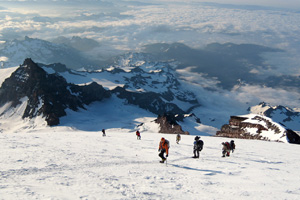
By Aubrey Laurence
Photo at right: Climbers on Mount Rainier’s Disappointment Cleaver route. Little Tahoma Peak is on the left. Photo courtesy of Aubrey Laurence.
Exhausted, irritable and oxygen-deprived, my wife and I sluggishly hiked up the rocky trail to the summit of Torreys Peak. It was 2003, and this was our first attempt at a Colorado 14er—a mountain between 14,000 and 14,999 feet in elevation. I thought it would be our last.
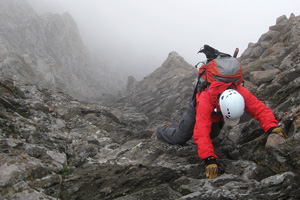
Author Aubrey Laurence climbs to the summit of Wetterhorn Peak, a 14er in the San Juan Mountains of Colorado. Photo courtesy of Jen Czak.
However, after finally gaining the summit, I became so enamored by the mountain that my attitude changed. Up on that lofty perch, with 360-degree views spilling far into a jagged horizon, I felt an awesome sense of accomplishment and freedom. Before I even made it back to the trailhead, I was already planning which 14er we were going to climb next.
In his book, “Walking Down the Wild,” Gary Ferguson describes this phenomenon best: “At the end of any wilderness trip there is always a sense of exhilaration, but never more so than when you’ve come face to face with physical exhaustion. It’s in this elated post-trek state that my mind begins a kind of editing, a myth-making, really—grinding down the sharp edges of the hard times and buffing the good ones to make them shine.”
Five years later, I scrambled to the top of my last unclimbed 14er in Colorado.
It was a life-affirming experience and one of my proudest achievements. It was just the beginning of an insatiable desire to climb more mountains in other states and countries. I pondered what was fueling that desire.
Why people climb
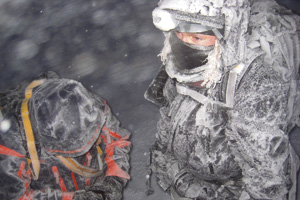
Guide Cosne (left) and climber Jen Czak are coated in rime ice at about 19,000 feet in a snowstorm on Cotopaxi in Ecuador. Photo courtesy of Aubrey Laurence.
“People climb for a huge variety of reasons,” says Jason Martin, climbing guide, instructor and Bellingham-based American Alpine Institute (AAI) operations manager. “I think the first reason people climb is because it’s fun. The sense of adventure might be another thing that draws people into climbing in the beginning, but that’s only part of it. There’s something special about climbing. And you create strong bonds while sharing a rope or being close to someone when they’re scared. Stressful situations create strong friendships.”
It’s difficult to put an exact number to the overall growth in mountain climbing, but there are signs of it everywhere. A good example of this climbing growth is AAI. Founded in 1975, it has grown from a staff of two to a full-time staff of six with approximately 40 guides.
Mount Rainier is also a good barometer for the growth of the sport because the National Park Service has been keeping records on the number of climbers on the mountain since 1950. In that first year, only 238 people attempted to climb Mount Rainier. Over the decades, that number has steadily risen to more than 10,000 per year.
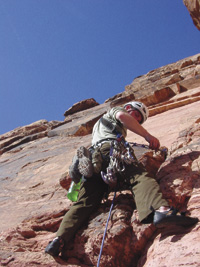
Rock climbing at Red Rocks near Las Vegas. Photo courtesy of Jason Martin of American Alpine Institute.
Beyond the obvious rewards of climbing, such as the spectacular views, the health benefits, the interesting characters and the exotic travel, many people climb because it provides them with something they can’t find anywhere else. Seasoned climbers sometimes answer the question “Why do you climb?” with the short and easy answer, “If you have to ask, you’ll never understand.”
However, it’s a good question to ask. Besides attempting to justify the associated risks, the question delves into the essence of the human spirit. It touches on who we are and where we are going. When we stop exploring and pushing ourselves to new heights (pun intended), we will begin to devolve.
Climbing may be hazardous
While climbing is inherently dangerous, hazards vary greatly depending on the mountain, the route and the conditions. Every climber has a different level of risk he or she is willing to accept. Plus, some climbers are better than others at risk assessment, which is a critical skill to learn in mountain climbing.
“With proper training, the dangers in climbing can be mitigated to where the risks are reasonable,” Martin says.
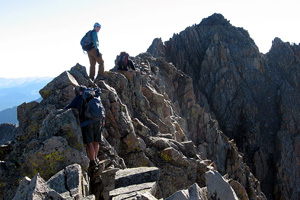
Jen Czak and others climbing the Ridge between El Diente Peak and Mount Wilson, two 14ers in Colorado. Photo courtesy of Aubrey Laurence.
When I’m climbing, especially when I’m in a challenging position, all of life’s mundane issues and day-to-day stressors fade away. Having the right teammates and gear, being properly conditioned and acclimatized, and having the right amount of experience to handle the challenge all coalesce into a harmonious flow. That’s when I feel a wonderful sense of clarity, focus and calm. Nowhere else in life do I feel more alive.
Through climbing, I have become more self-reliant. I have gained more self-confidence. I have become more humble, and have pushed past some of my deepest fears. Mountains have taught me countless lessons, and I’ve been able to transfer most of them to my everyday life.
All attempts to explain why people climb aside, sometimes the only way to answer the question is to climb a mountain yourself. Because, after all, you may be the only one who can truly discover the answer.
Aubrey Laurence and his wife Jen Czak have climbed hundreds of mountains throughout the United States and in a half-dozen countries. They currently live in Bellingham, Wash.



